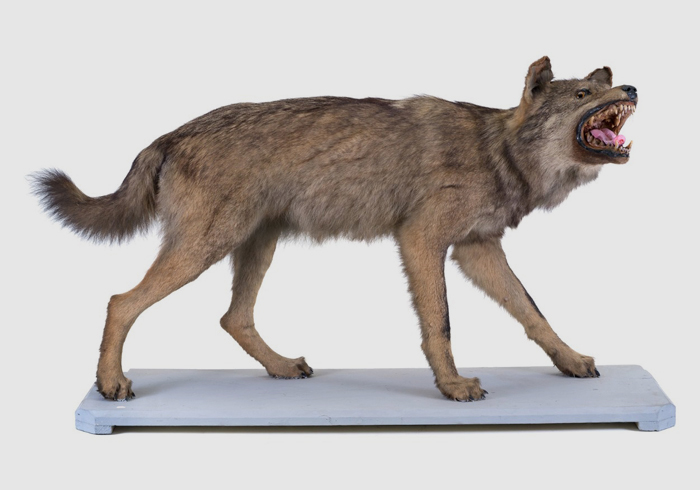Iberian wolf (Canis lupus signatus Cabrera, 1907) MUVHNZJ0328. Collection Padre Ignacio Sala S.J. Deposited in the M[UV]HN.

Wolves (Canis lupus) have always aroused interest and generated mixed feelings in popular culture. On the one hand, they remind us of our faithful friends, the dogs. On the other hand, popular stories have stigmatized them, portraying them as a shadowy enemy, lurking and waiting to attack and kill an easy prey; We all know how the story of Little Red Riding Hood ends…and what happened to Pedro with the wolf.
But far from these ideas, the wolf is an intelligent animal that lives in packs of between five and ten individuals, where a strict and well-defined hierarchical order is often imposed. We find an alpha male and female who dominate the other members of the pack and who tend to be their own offspring. They all cooperate to defend their territory and raise the pups, although dominance is exclusive to the breeding pair. Despite this, some groups are more lax than others. Body communication is very important between them. In this way, the dominant male usually imposes himself on the group by standing upright with his tail and ears raised. The wolf is an animal adaptable to various biotopes, being able to occupy from the tundra to the plain and mountain forests. Carnivore par excellence, it feeds on anything from small rodents to large ungulates such as deer (Cervus elaphus). Although it is not uncommon for it to occasionally compete with scavenging birds for the remains of animals, as well as to consume wild berries in certain seasons.
Specifically, this specimen is an Iberian wolf belonging to the subspecies Canis lupus signatus, endemic to the territory of the Iberian Peninsula. This subspecies was described by Ángel Cabrera in 1907, although its phylogenetic proximity to the European wolf leads some taxonomists to include it within the nominal subspecies C. l. lupus. “Signatus” means “signaled” or “marked” in Latin, referring to the white markings on the lips (mustache) and the dark vertical lines that run across its forehead, legs, tail, and withers. This subspecies presents medium-sized individuals, compared to the rest of the existing subspecies; It is not one of the largest we can find. The Iberian wolf, in addition, is within the group of "brown wolves", along with other subspecies.
In the image we can see one of the last wolves that populated the southern Iberian System, in the province of Teruel, killed in 1925. In Spain it has always been the antagonist at night, although there have been several decades in which it has not been seen. They have given attacks by these to humans. This has not prevented them from being hunted in numbers to the point of drastically reducing their populations. However, in 2021 the Spanish Government took a crucial step for the conservation of the Iberian wolf by declaring it a non-hunting species in the entire national territory, according to the order of the Ministry for the Ecological Transition published in the BOE, being included within the List of Wild Species under Special Protection Regime (Royal Decree 139/2011) not without controversy.
Despite this, we wish the Iberian wolf a long and full life.

















